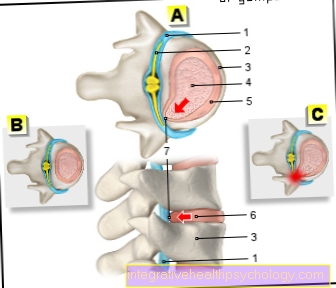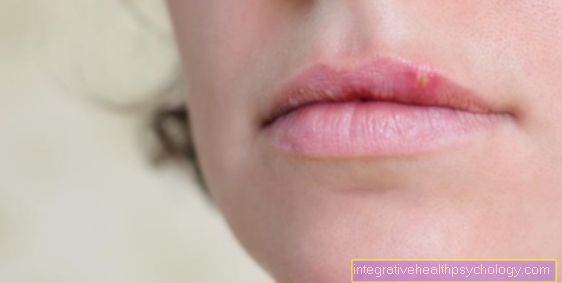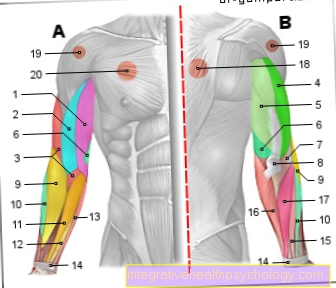Denture adhesive
Introduction to denture adhesives
A bad one prosthesis is for the prosthesis wearer when speaking or when Ingestion be a constant fear that dentures could loosen.
This is especially the case with full dentures. The partial dentures are so firmly anchored with clamps, attachments or telescopes that this problem does not arise.

history
In the past, people were badly seated Prostheses in the upper jaw attached by so-called suction cups. These were rubber plates that were attached to the prosthesis with a metal button. The negative pressure held the dentures then stuck to the palatal mucosa.
However, this constant negative pressure resulted in the bone on the roof of the mouth deteriorated and in the worst case the roof of the mouth was destroyed.
This method is no longer used today because better and, above all, less harmful methods are available.
Normal denture adhesion

With normal Jaw relationships the adhesion of a full denture in the upper jaw is not a problem.
At Dentures of the lower jaw however, it is more difficult to get the prosthesis to hold. The lever movements of the chewing and tongue muscles play a role here.
Read more on the topic: Dentures of the lower jaw
A prosthesis adheres to the mucous membrane through the Saliva film between mucous membrane and prosthesis and the absolute completion of the Valve rim in the Envelope fold. A good example to illustrate this is two sheets of glass that are placed on top of one another, are easy to separate, but with a layer of water in between, adhere firmly to one another. The adhesion of a prosthesis / prosthesis adhesive works according to the same principle. It is important that the saliva film does not tear off, which is why the Dentures raised lines attached, the so-called Frankfurt etching- to prevent the saliva film from tearing off.
Indication of a denture adhesive
The indications for the use of denture adhesives are unfavorable jaw relationships, caused by severe shrinkage of the alveolar process.
In the toothless lower jaw in particular, the alveolar bone is often so reduced that it is almost impossible for prostheses to adhere. Sufficient viscous saliva is also necessary for the tight fit of a prosthesis; this is sometimes not available in older people due to insufficient saliva production. Denture adhesives are also used for new dentures used to facilitate the acclimatization phase.
therapy

The best therapy for creating better adhesion of the prosthesis is the Relining with prosthetic materiall represent.
Either through direct relining with cold-curing plastic or indirect relining in the laboratory after the dentist has taken an impression.
Such relining may be necessary several times because the jaw can change. The use of implants also eliminates the problem. Finally, there are adhesive creams or powders on the market that are suitable for home use.
Adhesive cream as a denture adhesive
If the prosthesis does not hold, an adhesive cream can improve this condition considerably. The adhesive cream sticks the dentures not firm, but ensures optimal adhesion if the amount and consistency of the saliva are not sufficient to guarantee the natural hold.
The adhesives swell in the saliva and thus increase its viscosity. They form a film on the base of the prosthesis and thereby increase adhesion.
They also fill in any existing ones Cavities out. The adhesive also ensures an even pressure load when eating. The tighter fit of the prosthesis increases the comfort and safety of the prosthesis wearer. Adhesives should of course be harmless to the oral mucosa and the prosthesis material.
Most adhesives contain the active ingredient Methyl cellulose and have an immediate and long-term component. In addition to creams, adhesive powder is also offered. Powder is sprinkled evenly over the entire moist surface, while the cream is only applied partially and sparingly.
An excess of material can impair the adhesion. Some creams have to be applied to the moist, others to the dry denture base.
Mainly in the indentations that correspond to the alveolar ridge. Liquid presentations are the third type of adhesive, these are applied on the dry base. After applying the denture adhesive, you should press down firmly and wait a while before speaking and eating. The adhesive should be removed from the prosthesis daily.
Any adhesive residues left on the mucous membrane or the prosthesis can also be easily removed with cooking oil.
Adhesive pad
In addition to the adhesives, which are offered as creams, powders or liquids, there are also so-called adhesive pads. These are foils made of fleece which can be cut to the shape of the prosthesis and which are placed on the damp prosthesis. Like the other adhesives, they have to be changed again and again, otherwise they represent a particularly good breeding ground for germs.
Ingredients of the denture adhesives
Basically, it should be noted that an ideally adapted Denture even without using Denture adhesives firmly in the Oral cavity should sit. However, as this occurs in patients who suffer from a sharp decrease in the Jawbone or other irregularities, cannot be achieved in every case, denture adhesives are widely used in people with removable dentures. In addition, fixation of the denture with denture adhesives makes temporary (more provisional) Dentures make sense. Denture adhesives are in Pharmacies, Drugstores and Health food stores available.
They are in the form of:
- Anoint
- Stripes
- Foils
- liquids and even as
- powder offered.
Even the inexpensive, standard denture adhesive must meet the highest demands, both on the part of the dentist and on the part of the patient, because the preparations must ensure a firm hold of the removable denture within the oral cavity and still be removable without residue. In addition, a prosthesis adhesive should be well tolerated by the user and easy to handle. High demands are also made on the ingredients of the denture adhesives, because poisonous (toxic) substances cannot be used inside the oral cavity.
Even those ingredients that tend to affect the patient allergic reaction or triggering other hypersensitivity reactions are unsuitable for the manufacture of denture adhesives. In the manufacture of denture adhesives, natural and artificial (synthetic) Swelling substances back. However, the artificial ingredients now make up the main part of denture adhesives (exception: Sodium alginate). Swelling agents have the property of entering viscous solutions or suspensions with water, in this way the well-known adhesive effect can be achieved.
Denture adhesive without zinc
Zinc is contained in many adhesive creams to improve the hold of the denture. In addition, there is the anti-inflammatory effect, which has a positive effect on the sore areas, especially with pressure points. However, these adhesive creams can cause problems if another zinc preparation is taken orally.A so-called “zinc excess” can lead to a copper deficiency and thus to nerve damage. Even with allergy sufferers, a cream without zinc must be used. There are several preparations for this, for example from Corega or fitty dent.
What is the best way to remove the denture adhesive?
Denture adhesives should be removed daily during morning oral hygiene. For care, you take the prosthesis out of your mouth and then clean it with warm water and a special prosthesis brush. This often has long, curved bristles and a specially pointed bristle field to thoroughly clean even the smallest areas. Washing-up liquid can be used as an aid.
So that even stubborn dirt disappears, it can be helpful to soak the denture beforehand with a denture cleaner tablet. If the dentures are not regularly removed from the adhesive cream, plaque will form. At Plaque it is dental plaque, i.e. a film of bacteria which Caries and Periodontal disease caused. This can solidify on dentures and then settle as tartar.
Because of this Inflammation of the gums one must prevent this process. When cleaning, the sink should always be filled with a little water to prevent the denture from breaking. If a plastic or ceramic prosthesis falls directly on the sink, it often breaks into several parts.
Summary
The comfort of a Full denture mainly depends on the tight fit of the dentures. Unfavorable jaw conditions or too thin saliva impair the hold of prostheses.
Full dentures are adhered to by adhesion, with the saliva forming the connection between the prosthesis and the mucous membrane. A relining is the best measure to give the prosthesis a firm hold again.
If adhesion is still not guaranteed, denture adhesives can be helpful and give the patient confidence when speaking and eating. They are available in different versions. All are harmless to health and can be used by the patient himself. Daily replacement is necessary to prevent colonization with germs. Leftovers can easily be removed with cooking oil.



























